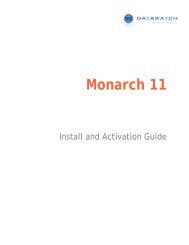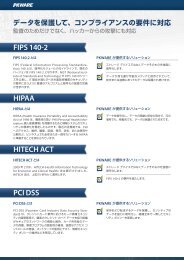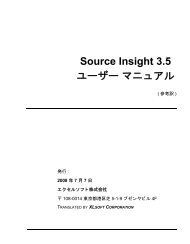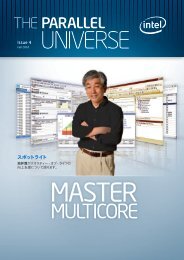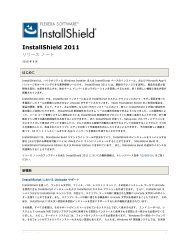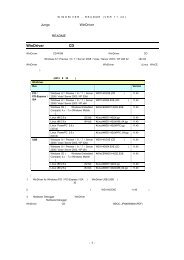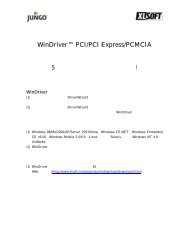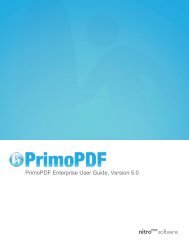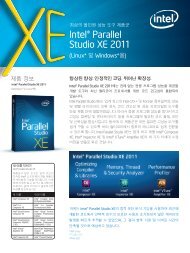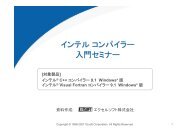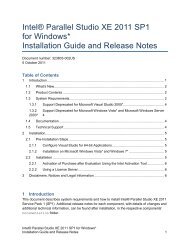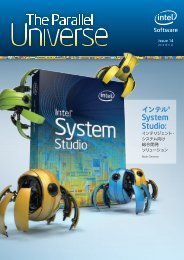Microsoft Health Solutions Group Uses MadCap Flare to Streamline ...
Microsoft Health Solutions Group Uses MadCap Flare to Streamline ...
Microsoft Health Solutions Group Uses MadCap Flare to Streamline ...
Create successful ePaper yourself
Turn your PDF publications into a flip-book with our unique Google optimized e-Paper software.
<strong>Microsoft</strong> <strong>Health</strong> <strong>Solutions</strong> <strong>Group</strong> <strong>Uses</strong> <strong>MadCap</strong> <strong>Flare</strong> <strong>to</strong> <strong>Streamline</strong><br />
Delivery of Amalga UIS Online and Print Documentation<br />
In 2009, the United States government has highlighted the need for<br />
the healthcare industry <strong>to</strong> embrace online data management <strong>to</strong><br />
improve care and control rising costs.<br />
<strong>Microsoft</strong> <strong>Health</strong> <strong>Solutions</strong> <strong>Group</strong><br />
Redmond, WA<br />
http://www.microsoft.com/amalga<br />
Industry:<br />
• <strong>Health</strong>care<br />
• Enterprise Software<br />
Goals:<br />
• <strong>Streamline</strong> process of content<br />
development and delivery<br />
• Enable greater au<strong>to</strong>mation through<br />
source-control integration<br />
• Improve process of updating API<br />
SDK for partners<br />
Solution:<br />
• <strong>MadCap</strong> <strong>Flare</strong> native XML<br />
multi-channel content authoring<br />
software<br />
Benefits:<br />
• Single sourcing enables 11 online<br />
and print documentation outputs<br />
<strong>to</strong> be built in two days<br />
• Source-control integration via<br />
XML code and <strong>Flare</strong> snippets<br />
facilitates development of partner<br />
API SDK<br />
• User friendly interface helps<br />
writers <strong>to</strong> get up and running<br />
quickly<br />
• Variables and the separation of<br />
content from style give writers<br />
maximum flexibility in publishing<br />
content<br />
<strong>Microsoft</strong> <strong>Health</strong> <strong>Solutions</strong> <strong>Group</strong> (HSG), an innova<strong>to</strong>r in this sec<strong>to</strong>r,<br />
already is helping hospitals such as Johns Hopkins Medicine,<br />
NewYork-Presbyterian, El Camino Hospital, and Seattle Children’s<br />
Hospital <strong>to</strong> enhance their care and efficiency through its healthcare<br />
information solutions. Hand-in-hand with those solutions is leadingedge<br />
documentation on how <strong>to</strong> effectively use them.<br />
Today, <strong>Microsoft</strong> HSG is using <strong>MadCap</strong> <strong>Flare</strong> <strong>to</strong> streamline the<br />
publishing of print and online documentation for the newest version<br />
of its Amalga Unified Intelligence System (UIS) 2009, which was<br />
launched in April 2009.<br />
Based on its initial success with the Amalga UIS documentation,<br />
<strong>Microsoft</strong> HSG plans <strong>to</strong> extend <strong>Flare</strong> across the HSG enterprise group<br />
and is investigating the potential for using <strong>Flare</strong> across the entire<br />
HSG division.<br />
Multiple Cus<strong>to</strong>mers and SKUs Add Complexity<br />
<strong>Microsoft</strong> Amalga UIS is a next-generation enterprise data aggregation<br />
platform that enables hospitals <strong>to</strong> unlock patient data s<strong>to</strong>red in<br />
a range of systems and make it easily accessible <strong>to</strong> every authorized<br />
member of the team inside and beyond the hospital — including<br />
the patient — <strong>to</strong> help drive real-time improvements in the<br />
quality, safety and efficiency of care delivery.<br />
Prior <strong>to</strong> Amalga UIS 2009, the <strong>Microsoft</strong> HSG documentation team<br />
manually created different documents and had no online SDKs <strong>to</strong><br />
support the software. This need <strong>to</strong> manage multiple cus<strong>to</strong>mer<br />
versions, along numerous SKUs, led <strong>to</strong> significant redundancies in<br />
development and quality control.<br />
The launch of Amalga UIS 2009 required new print and online<br />
documentation—providing an opportunity <strong>to</strong> select the documentation<br />
publishing software that would enable the writers <strong>to</strong> best<br />
meet cus<strong>to</strong>mers’ needs. <strong>Microsoft</strong> HSG evaluated the industry’s<br />
leading authoring solutions, many of which have been on the<br />
market for more than a decade. After careful review, the documentation<br />
team chose relative newcomer <strong>MadCap</strong> <strong>Flare</strong> with its<br />
next-generation approach <strong>to</strong> authoring and managing content<br />
workflow.
“<strong>MadCap</strong> <strong>Flare</strong> is giving us state-of-the-art capabilities while offering<br />
the lowest cost of ownership of any authoring software we’ve seen<br />
on the market,” said Harold Gross, documentation manager for the<br />
<strong>Microsoft</strong> Amalga product line.<br />
“Most authoring products are based on proprietary code or other<br />
special coding that makes it difficult <strong>to</strong> move away from them,”<br />
Gross explained. “With <strong>Flare</strong>’s native XML architecture, we could<br />
easily migrate the content <strong>to</strong> another application, but its powerful<br />
functionality and ease of use remind us why we want stay with <strong>Flare</strong><br />
every time we use it.”<br />
“The single-sourcing in<br />
<strong>Flare</strong> is tremendously<br />
advantageous for quickly<br />
delivering the content<br />
our cus<strong>to</strong>mers need.<br />
We’ve taken a huge leap<br />
with <strong>Flare</strong>, and there’s still<br />
a lot more potential <strong>to</strong><br />
tap.”<br />
—Harold Gross<br />
Documentation Manager,<br />
<strong>Microsoft</strong> <strong>Health</strong>care<br />
Systems <strong>Group</strong><br />
Single Sourcing Speeds Delivery, Removes Redundancies<br />
Key fac<strong>to</strong>rs in <strong>Microsoft</strong> choosing <strong>Flare</strong> are its native XML architecture,<br />
single-source publishing, and the ability <strong>to</strong> add seamless source<br />
control integration.<br />
“We have a broad range of cus<strong>to</strong>mers for our Amalga UIS software<br />
that includes everyone from database analysts at the backend <strong>to</strong><br />
nurses on the hospital floor, so we need <strong>to</strong> deliver information in a<br />
variety of formats,” said Gross.<br />
Gross added, “The single-sourcing in <strong>MadCap</strong> <strong>Flare</strong> is tremendously<br />
advantageous for quickly delivering the content our cus<strong>to</strong>mers<br />
need. Once we developed the documentation, it <strong>to</strong>ok us just two<br />
days <strong>to</strong> build two CHM files for our SDKs, nine PDF manuals, and a full<br />
Web Help version of all the documentation <strong>to</strong> meet the deadline for<br />
our product launch.”<br />
Another important fac<strong>to</strong>r is the availability of variables and conditional<br />
text <strong>to</strong> support content reuse and consistency, said Gross,<br />
who notes, “<strong>Flare</strong>’s approach <strong>to</strong> variables is very slick. We like the<br />
way we can override variables for a particular target. “The variables<br />
combined with the separation of content and style give us a great<br />
deal of flexibility.”<br />
The team also liked the fact that <strong>Flare</strong> did not require schema<br />
locking. Instead, by separating the structure from style, <strong>Flare</strong><br />
provided <strong>Microsoft</strong> HSG’s writers with the flexibility <strong>to</strong> present data<br />
across different <strong>to</strong>pics in the most effective way possible.<br />
As soon as <strong>Flare</strong> was in place, the <strong>Microsoft</strong> HSG documentation<br />
team was able <strong>to</strong> get up and running quickly, Gross noted: “The<br />
learning curve was a low ramp. In fact, most of our challenges were<br />
with people learning how <strong>to</strong> write for single-sourcing and figuring out<br />
what content they could turn in<strong>to</strong> snippets for reuse. Once they got<br />
it, our snippet collection exploded.”
<strong>Flare</strong> Enables Sophisticated Au<strong>to</strong>mation Integration<br />
<strong>Microsoft</strong> HSG’s technical writers soon went beyond basic content<br />
reuse with snippets <strong>to</strong> sophisticated au<strong>to</strong>mation integration. Utilizing<br />
XSLT <strong>to</strong> reflect against the Amalga UIS product code, snippets are<br />
created for the API software developer’s kit (SDK) for partners. These<br />
snippets are extractions of comments in the constantly changing<br />
code. Finally, the snippets are then inserted in<strong>to</strong> the broader documentation<br />
source control.<br />
“With <strong>Flare</strong>’s native XML<br />
architecture, we could easily<br />
migrate the content <strong>to</strong><br />
another application, but its<br />
powerful functionality and<br />
ease of use remind us why<br />
we want stay with <strong>Flare</strong><br />
every time we use it.”<br />
—Harold Gross<br />
Documentation Manager,<br />
<strong>Microsoft</strong> <strong>Health</strong>care<br />
Systems <strong>Group</strong><br />
“This is the most effective way <strong>to</strong> update the API SDK that we’ve<br />
produced <strong>to</strong> date,” Gross says, “Moreover, because <strong>Flare</strong> is pure<br />
XML, we were able <strong>to</strong> develop our source-control integration<br />
solution on our own with just four weeks of effort. Going forward, we<br />
have a roadmap for au<strong>to</strong>mating this process even further.”<br />
In addition <strong>to</strong> expanding the functionality of documentation and<br />
online developer Help for Amalga UIS, <strong>Microsoft</strong> HSG also plans <strong>to</strong><br />
localize it for cus<strong>to</strong>mers worldwide. <strong>Flare</strong>’s Unicode support and<br />
command line compiler, which enables bidirectional text, will play<br />
an important role in facilitating the translation.<br />
“Because <strong>Flare</strong> provides a command line compiler that can handle<br />
right-<strong>to</strong>-left languages, such as Hebrew and Arabic, as well left-<strong>to</strong>right<br />
Western and Asian languages,” Gross explains, “that means we<br />
can simply send the original source content for localization. Once<br />
the translated content comes back, it becomes part of the project<br />
that we can have <strong>Flare</strong> build.”<br />
“We’ve taken a huge leap with <strong>Flare</strong>,” Gross adds, “And there’s still<br />
a lot more potential <strong>to</strong> tap.”<br />
Published May 2009<br />
<strong>MadCap</strong> Software, Inc.<br />
7777 Fay Avenue,<br />
La Jolla, California 92037<br />
www.madcapsoftware.com<br />
+1 858.320.0387<br />
To learn more, visit <strong>MadCap</strong> Software at:<br />
www.madcapsoftware.com<br />
Copyright © 2009, <strong>MadCap</strong> Software, Inc. and its licensors. All rights reserved. <strong>MadCap</strong> Software, the <strong>MadCap</strong> Software logo, <strong>MadCap</strong> <strong>Flare</strong>, <strong>MadCap</strong> Blaze, <strong>MadCap</strong> Mimic, <strong>MadCap</strong> Capture,<br />
<strong>MadCap</strong> Echo, <strong>MadCap</strong> Analyzer, <strong>MadCap</strong> Press, <strong>MadCap</strong> X-Edit, <strong>MadCap</strong> Feedback, <strong>MadCap</strong> Team Server, and <strong>MadCap</strong> Lingo are trademarks or registered trademarks of <strong>MadCap</strong> Software, Inc. in<br />
the United States and/or other countries. Other marks are the properties of their respective owners.



